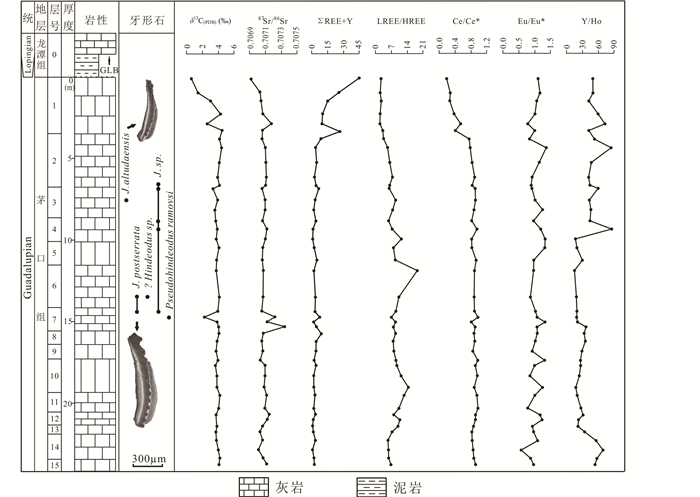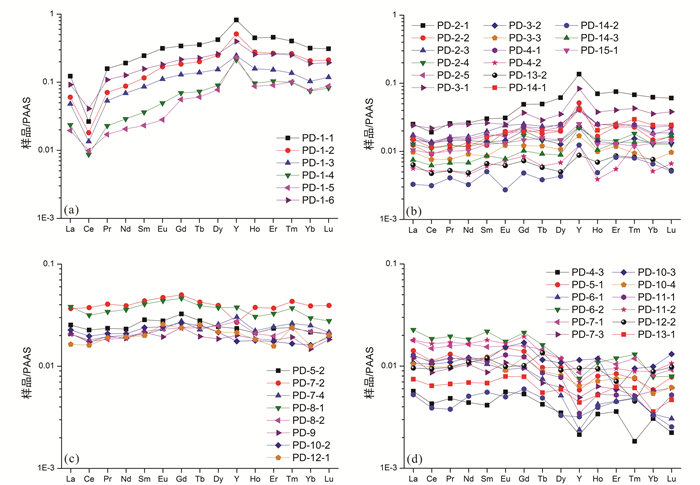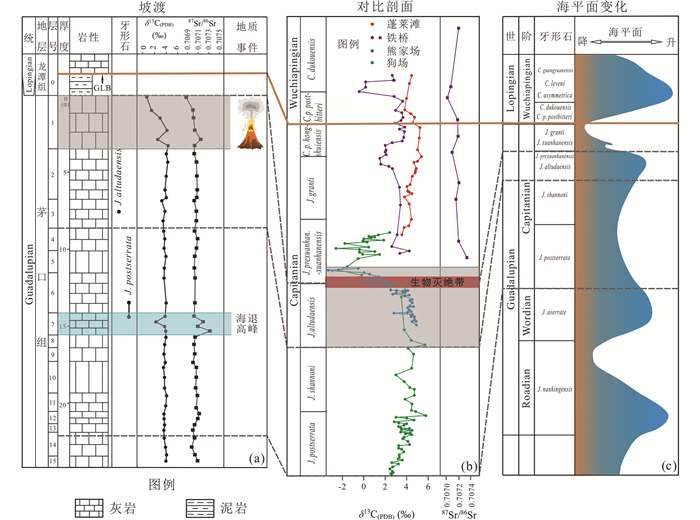2. 成都理工大学能源学院, 成都 610059;
3. 成都理工大学地球科学学院, 成都 610059
2. College of Energy Resources, Chengdu University of Technology, Chengdu 610059, China;
3. College of Earth Sciences, Chengdu University of Technology, Chengdu 610059, China
晚二叠世是地质发展史上重要的变革时期,大规模的构造运动与火山-岩浆事件,引发了生物大灭绝,导致超过90%海洋生物的瞬间消失,70%陆生脊椎生物种群濒于灭绝(Erwin, 1994)。这场巨大规模的生物灭绝事件包含了两次独立事件,分别为Guadalupian末期(~260Ma)生物危机和二叠纪末期(~252Ma)生物灭绝(Jin et al., 1994; Stanley and Yang, 1994; Clapham et al., 2009; Clapham and Payne, 2011; Payne and Clapham, 2012; 沈树忠和张华, 2017)。针对Guadalupian末期(~260Ma)生物危机的研究注重于成因机制,主要涉及到全球气候变化(Isozaki et al., 2007a, b)、大规模海退(Shen and Shi, 2002; Yang et al., 2004; Wignall et al., 2009a)、深海缺氧(Weidlich, 2002; Clapham et al., 2009)、甲烷释放(Retallack et al., 2006)、火山喷发(Ali et al., 2002; Wignall et al., 2009b)等。大多数学者将此次生物危机归因于海退事件和火山喷发事件,例如:Wang et al. (2004)和Wignall et al. (2009b)在广西来宾蓬莱滩、铁桥地区调查发现:生物种群的锐减和碳同位素负异常,与同期大规模浅水相地层的出现有关,确认为一期海退事件,且进一步的研究还对海退高峰的时限进行了有效的约束(位于J. xuanhanensis与J. granti交界和J. granti带内)。Wignall et al. (2009a)和Bond et al. (2010b)通过对贵州熊家场等多个剖面调查,确认生物危机事件发生在J. prexuanhanensis-J. xuanhanensis带内,并在剖面中发现了生物危机和玄武岩关系的关键证据,认定这场危机与同期的峨眉山大火成岩省事件有关联。Saitoh et al. (2013)在四川广元朝天剖面J. postserrata-J. shannoni牙形石带地层中发现浅水海洋生物种群批量消亡,认为在Capitanian(卡匹敦期)时期,扬子克拉通西部曾经发生过两阶段的大规模海侵,而在G-L(瓜德鲁普统-乐平统)界线附近发生快速海退。韦雪梅等(2016)报道了晚二叠世海相碳酸盐地层中存在两期碳同位素负偏移,一幕出现在Capitanian中期,另一幕则接近于G-L界线。因此,Guadalupian海退事件和火山喷发在时间和空间上的配置以及相关的地球化学响应,及其对生物危机的影响仍亟需解决。
海相化学沉积物蕴含有与地壳构造变动、陆地-海洋物质循环以及生物灭绝等相关联的各种地质事件的化学指纹信息(闫秋实和施泽进, 2016),其中,微量元素与同位素体系能够反映地幔和大陆源区之间以及表生环境相互作用的平衡关系(汤好书等, 2009)。基于此,本文在已有工作的基础上,着重调查四川盆地东南缘的坡渡海相碳酸盐岩剖面,分析研究了晚Guadalupian统碳酸盐岩地层的稀土元素及碳、锶同位素演化特征,探讨晚Guadalupian的生物危机事件与大规模海退及峨眉大火成岩省事件之间的耦合关系。
1 地质背景四川盆地位于扬子克拉通西北部,北以米仓山和大巴山为界,南为大娄山,东与中扬子区相接,西缘为龙门山-安宁河大断裂,哀牢山-红水河走滑断裂带,小江断裂,以及西昌-巧家断裂等。二叠纪前,四川盆地长期遭受剥蚀,形成了准平原化古地貌;早二叠世开始广泛的海侵,下二叠统梁山组地层超覆于石炭系、泥盆系、志留系及奥陶系之上;中二叠统四川盆地及邻区沉积了栖霞组和茅口组碳酸盐岩地层,茅口组厚达119~508m,平均为237m(李大军等, 2016; 刘树根等, 2017)。中二叠世末期受东吴运动抬升的影响,茅口组顶部遭受不同程度的剥蚀,依据剥蚀程度,He et al. (2003)将茅口组地层剥蚀带分成了内带、中带、外带与连续沉积带。中二叠世晚期,扬子克拉通西缘爆发了大规模的火山喷发,形成峨眉山大火成岩省。西南以哀牢山-红河断裂为界,西北以龙门山断裂带为界,峨眉山大火成岩省覆盖面积达2.5×105km2,岩体厚度西厚东薄,内带地区厚达5km,外带则变薄至几十至几百米,原始喷发量接近3.8×106km3(He et al., 2003; Xu et al., 2010)。
坡渡剖面位于四川盆地东南部的重庆市綦江县(图 1),茅口组地层有大面积的出露。茅口组顶部地层岩性以浅-深灰色中至厚层状微晶灰岩为主,局部夹硅质结核和条带,与上覆龙潭组底部泥岩段不整合接触。本文的研究对象为茅口组顶部厚约24m的碳酸盐岩地层,依据岩性特征、层理厚度,由上至下共划分为15层。

|
图 1 华南地区Guadalupian世古地理图(据Wang and Jin, 2000; He et al., 2003修改) Fig. 1 Sketch map of Guadalupian lithofacies palaeogeography in South China (modified after Wang and Jin, 2000; He et al., 2003) |
本文大致以0.5m为间隔,对茅口组顶部地层逐层采样,共采集42件灰岩样品。为真实反映原始海水特征,样品在采集过程中避开裂缝、脉体、重结晶区域,室内用微钻钻取样品,并用玛瑙研钵研磨至直径0.075mm以下,然后进行同位素及稀土元素分析。
碳同位素分析由成都理工大学同位素地球化学实验室完成。实验步骤如下:称重0.5mg样品放入Gas-Bench自动采样系统中,充入高纯He清洗,加入100% H3PO4恒温70℃溶解2h。测试仪器为Thermo Fisher Scientific MAT253同位素质谱仪,Vienna Pee Dee Belemnite (VPDB)作为标样,测试误差为±0.02‰。
锶同位素分析由成都理工大学油气藏地质及开发工程国家重点实验室完成,实验步骤如下:50mg样品溶于1M超纯醋酸,于电热板上恒温60℃反应12h经离心蒸干后,加入1.5mL 2.5M HCl进行溶解,离心后提取1.5mL的纯溶液,并采用AG 50W-X12型阳离子树脂进行分离与提纯。87Sr/86Sr比值的测试用Thermo Fisher Scientific TRITON Plus质谱仪进行,按照86Sr/88Sr=0.1194的质量分馏标准进行校正。测得的标准样品NBS 987的平均值为0.710247±0.000008(2σ, n=6),表明测试数据有效。
稀土元素测试由成都理工大学同位素地球化学实验室完成,为避免陆源碎屑组分的影响,溶样时避免使用HNO3、HF等强酸。具体流程如下:称取100mg样品于聚四氟乙烯消解罐,加入3mL 2MHCl,置于电热板上180℃加热48h,所得溶液经离心蒸干后,重溶于1.0mL纯HNO3,并用超纯水稀释至100g,用PerkinElmer ELAN DRC-e电感耦合等离子体质谱仪进行测试,测试误差小于5%。
3 测试结果 3.1 Mn和Sr含量依据Mn、Sr元素含量可以判别样品是否受到成岩蚀变的影响,当样品的Mn含量 < 250×10-6以及Sr含量>400×10-6,或者Mn/Sr < 0.625时,则认为样品没有受到成岩蚀变的影响(Bruckschen et al., 1999; Korte et al., 2003, 2005)。本次测试分析结果显示,所采样品Mn含量的范围为10×10-6~156×10-6,Sr含量的范围为590×10-6~1097×10-6,Mn/Sr比 < 0.258,表明样品未受到成岩蚀变的影响,能反映原始海水信息(表 1)。
|
|
表 1 四川盆地坡渡剖面碳酸盐岩碳-锶同位素特征 Table 1 Carbon and strontium isotopic characteristics of carbonate in Podu section of Sichuan Basin |
δ13Ccarb值变化范围为0.88‰~4.40‰,87Sr/86Sr波动范围为0.70689~0.70731。15层至8层δ13Ccarb值波动幅度小,介于3.62‰~4.13‰之间,87Sr/86Sr比值范围为0.70697~0.70712;到第7层发生较大波动,δ13Ccarb从4.06‰负偏至2.35‰,相应的87Sr/86Sr比值从0.70702上升到0.70731;6层至3层,碳同位素轻微降低,87Sr/86Sr略增加;第3层开始,δ13Ccarb突然出现剧烈负偏,87Sr/86Sr同步降低,到茅口组顶部降至最低,δ13Ccarb为0.88‰,87Sr/86Sr为0.70689(表 1、图 2)。

|
图 2 四川盆地坡渡剖面碳-锶同位素与稀土元素演化曲线 Fig. 2 Evolution curves of carbon-strontium isotope and rare earth element of Podu section in Sichuan Basin |
碳酸盐岩中稀土元素来源主要包括:1)通过河流搬运的陆源成因溶解物质;2)海底和大陆火山喷发的溶液、气体及地壳深部物质;3)形成碳酸盐岩的生物(高长林, 1992; Frimmel, 2009)。海水具有较低的稀土总量,页岩标准化的配分模式具有轻稀土亏损、Ce负异常、Y正异常、轻微的正La异常特征,相反,陆源物质具有高的稀土总量,显著的轻稀土或中稀土富集和并不具明显的元素异常,而地幔、超基性、基性岩中重稀土占优势,陆壳、酸性岩和碱性岩中则富集轻稀土(Sholkovitz and Shen, 1995; Reynard et al., 1999; Bolhar et al., 2004; Nothdurft et al., 2004; Bright et al., 2009; Frimmel, 2009; 周国兴等, 2014)。因而,外源流体进入海洋将会使稀土元素地球化学特征发生变化(Bolhar et al., 2004; Nothdurft et al., 2004),这就为综合稀土元素配分模式、Ce/Ce*、Eu/Eu*、LREE/HREE等特征参数以及碳、锶同位素的演化特征去研究Guadalupian晚期地质事件提供了途径。
稀土元素测试结果如表 2所示,所有样品的稀土元素采用澳大利亚页岩(PAAS-Post Archaean Australian Shale; McLennan, 1989)为标准进行标准化。页岩标准(SN)元素异常分别采用以下方法计算:La/La*=LaSN/(3×PrSN-2×NdSN)(Bolhar et al., 2004),Ce/Ce*=2×CeSN/(LaSN+PrSN),Eu/Eu*=EuSN/(0.67×SmSN+0.33×TbSN)(Bau and Dulski, 1996)。
|
|
表 2 四川盆地坡渡剖面碳酸盐岩稀土元素分析结果(×10-6) Table 2 Rare earth element results (×10-6) of carbonate in Podu section of Sichuan Basin |
测试结果显示,茅口组碳酸盐岩样品稀土总量介于0.90×10-6~45.26×10-6之间,均值为6.07×10-6(表 2),符合碳酸盐岩稀土含量低的特点。稀土总量呈现先增长后下降、而后大幅度增长的趋势(图 2):自15层开始,稀土总量低,从13层开始含量增加,到第7层达到高值,随后降低,直至第1层样品稀土总量达最高,范围为10.15×10-6~45.26×10-6,且呈明显的增长趋势。
样品的轻、重稀土比值(LREE/HREE)介于1.94~18.3之间,均值为7.99,显示出相对富集轻稀土的特征。LREE/HREE比值整体呈先增长、后下降的趋势,第15层及第14层,LREE/HREE比值较小,第13层至第4层比值较高,第3层至第1层,比值逐渐降低(表 2、图 2)。
Ce通常用于指示海水的氧化环境。Ce具有Ce3+和Ce4+两种价态,在氧化环境下被氧化成Ce4+,形成难溶的氢氧化物而脱离海水,导致海相碳酸盐岩具有负Ce异常的特点。本次样品的Ce/Ce*范围在0.19~0.97之间,除第一层样品表现为明显的Ce负异常,范围为0.19~0.54,反映当时海水为氧化环境之外,其余层位都为弱Ce负异常(表 2)。
Eu是唯一一个可以从3价态Eu3+还原为2价态Eu2+的稀土元素,在常温常压环境中,Eu2+只能在极端还原的条件下才能大量存在,而在高温的还原性热液流体中(>250℃),Eu2+稳定性增加,能大量富集(Sverjensky, 1984; Bau, 1991)。本次测试结果显示,Eu/Eu*为0.59~1.38,平均为1.05,不具有明显的异常(表 2),表明受热液影响程度低。
海水以及海相沉积物的Y/Ho比值较高,一般大于44,而陆源岩石与球粒陨石比值较低,约为26(Bolhar et al., 2004)。测试结果显示,15至14层以及4至1层,Y/Ho比高于40,反映海水沉积的特点;13层至6层,Y/Ho比值普遍小于30,表明受到了陆源物质的影响(表 2)。
依据稀土元素标准化配分模式图,可以将该剖面碳酸盐岩样品分为四类。第一类,稀土总量偏高,轻重稀土分异明显,重稀土富集,轻稀土亏损,曲线左倾,Ce呈显著负异常,Y呈正异常,主要见于第1层(图 3a);第二类稀土总量低,重稀土较富集,曲线略左倾,Ce表现为弱负异常,Eu无明显异常,Y呈正异常,主要见于第15层、14层、13层、4层、3层以及2层(图 3b);第三类稀土总量较低,曲线平坦,无明显分馏,Ce无异常或弱负异常,Eu无明显异常,主要见于第12层、10层、9层、8层、7层以及5层(图 3c);第四类表现为稀土总量低,轻稀土富集,重稀土亏损,曲线略右倾,Ce无异常或弱负异常,Eu无明显异常,主要见于13层、12层、11层、10层、7层、6层、5层以及4层(图 3d)。

|
图 3 四川盆地坡渡剖面碳酸盐岩样品稀土元素配分模式图 Fig. 3 REE+Y patterns for carbonate samples from Podu section in Sichuan Basin |
为获得准确的地层沉积时代,利用生物地层学原理,用醋酸溶解碳酸盐岩后挑选牙形石进行了鉴定。本次研究共发现牙形石样品10个,其中1个归于Hindeodus属,9个归于Jinogondolella属,可识别出J. postserrata、J. altudaensis两个种。其中,J. postserrata齿台狭窄,前端横脊发育,中后部两侧近似平行,后部略收缩,轻微侧弯,锯齿直立并向齿台中部逐渐缩小;J. altudaensis齿台较平坦,近脊沟较浅,主齿较小,锯齿更融合,前端横脊不发育(图 2)。依据牙形石组合特征,将本次研究剖面时限限定为Guadalupian晚期。
醋酸溶解后的残余物,包含大量陆源碎屑,主要出现在第7层。本文挑选其中有代表性的矿物,利用电子探针鉴定了物质成分,主要为典型的岩浆和变质矿物,包括云母、石英和其他的硅酸盐矿物(图 4、表 3),这些陆源碎屑物质可能与海退事件有关。

|
图 4 四川盆地坡渡剖面第7层样品溶解残余陆源碎屑物质s 1-云母;2-石英;3-红柱石;4-榍石 Fig. 4 Residues bearing terrigenous materials of sample from Bed 7 after dissolving by acetic acid 1-mica; 2-quartz; 3-andalusite; 4-titanite |
|
|
表 3 四川盆地坡渡剖面第7层样品溶解残余物质电子探针分析结果(wt%) Table 3 Electron probe analysis results (wt%) of dissolved residual material from Bed 7 in Podu section of Sichuan Basin |
坡渡剖面碳酸盐岩地层中记录了两期地球化学数据的明显波动,其中第一期变化发生在第13层至第4层。如图 2所示,第15层至第8层碳、锶同位素波动较小,首次明显变化发生在第7层,出现一次显著的同位素偏移,恰好落在J. postserrata牙形石带。87Sr/86Sr比值由第8层的0.70704急剧升高至第7层的0.70731,同时δ13Ccarb也发生同步负偏移,由4.06‰减小至2.35‰。稀土元素总量变化较小,在第7层达到第一次峰值;Y/Ho比值从13层开始急剧变小,比值落在15.3~37.3范围内,普遍小于30;13层至4层稀土配分模式主要为轻稀土相对富集的右倾型(图 3d),少量为平坦型(图 3c)。除同位素与稀土元素发生显著变化之外,在第7层还发现了大量陆源碎屑物质,如云母、石英和其他的硅酸盐矿物(图 4、表 3)。
碳、锶同位素和稀土元素的同步变化,以及大量陆源碎屑物质的集中出现,揭示了一期海退事件。伴随水体变浅,陆源物质向海洋供给量加大,富集陆源放射性成因87Sr与富12C的陆源流体快速进入海洋,引起海相碳酸盐岩地层中87Sr/86Sr同位素比值的相对升高,以及δ13Ccarb比值的同步降低。同时,受陆源流体影响,从13层开始Y/Ho比值急剧变小,稀土配分模式发生改变,轻稀土相对富集。依据同位素、稀土元素变化规律,以及大量陆源物质的出现层位,这起海退事件有可能从13层开始,到第7层达到高峰,落在J. postserrata牙形石带。
众多文献对Guadalupian晚期的海退事件进行了报道(Wang and Jin, 2000; Shen et al., 2007; Lai et al., 2008; Wignall et al., 2009a; Chen et al., 2009; Bond et al., 2010a; Saitoh et al., 2013; Qiu et al., 2014)。例如,Wignall et al. (2009a)在广西来宾蓬莱滩和铁桥剖面发现了与浅水环境有关的沉积构造和与风暴活动有关的丘状交错层理,以及相应的锶同位素负偏移(图 5b),并把海退事件高峰期分别限定在蓬莱滩剖面第5b层和铁桥剖面第5层,对应于J. xuanhanensis-J. granti带;Lai et al. (2008)认为四川盆地北部广元上寺与朝天剖面J. postserrata带内出现的碳同位素负偏移是海退事件的响应,Saitoh et al. (2013)在朝天剖面也发现J. postserrata带处于浅水沉积环境;Chen et al. (2009)和Qiu et al. (2014)的研究认为,Guadalupian时期广西来宾地区发生了多期海退事件,其中第一期发生于Guadalupian早期(Roadian:罗德期),第二期发生于Guadalupian中晚期,高峰期在J. postserrata-J. shannoni带界线处,第三期发生在Guadalupian晚期,开始于J. prexuanhanensis带(图 5c),对应于G-L界线附近全球范围内大规模海平面下降事件(Haq and Schutter, 2008)。本文发现的海退事件出现在J. postserrata带,与Wignall et al. (2009a)所指的来宾地区海退事件相差3个牙形石带,但对应于Chen et al. (2009)和Qiu et al. (2014)报道的第二次海平面下降,并且和Lai et al. (2008)、Saitoh et al. (2013)在四川盆地广元地区发现的J. postserrata带内沉积环境的变化相吻合,表明这次海退事件波及范围较广。

|
图 5 四川盆地坡渡剖面与华南其他剖面同位素特征及地质事件对比图 图b中数据引自Wang et al., 2004; Wignall et al., 2009a; Bond et al., 2010a; 图c海平面变化曲线引自Chen et al., 2009 Fig. 5 Comparison chart of isotope characteristics and geological events of Podu section in Sichuan Basin and other sections Data in Fig. 5b are cite from Wang et al., 2004; Wignall et al., 2009a; Bond et al., 2010a; sea level curve in Fig. 5c after Chen et al., 2009 |
何斌等(2006)、张廷山等(2011)、杨巍等(2014)基于地层厚度、岩性、古生物及地球化学特征等,对栖霞组、茅口组沉积相、古地理进行了系统分析,发现峨眉山地幔柱活动形成的穹窿状地壳隆升,控制并影响了扬子克拉通西部中二叠世古地理格局及演化。在全球海平面处于长期下降旋回的背景下(Haq and Schutter, 2008),Guadalupian时期扬子克拉通西部发生的海退事件,除了受到全球海平面变化的影响,还可能受峨眉山地幔柱活动的影响。
4.1.2 火山喷发事件坡渡剖面第二次碳、锶同位素与稀土元素的显著变化出现在第1层,对应于J. altudaensis牙形石带。87Sr/86Sr与δ13Ccarb值发生了同步负偏移,87Sr/86Sr比值从0.70714降到了最小值0.70689,δ13Ccarb从4.40‰降到了0.88‰(图 2、表 1);同时,稀土总量上升,涨幅约7倍,稀土配分模式改变,由第2层的相对平坦型变为重稀土相对富集的左倾型,Ce出现明显负异常(图 3、表 2)。
87Sr/86Sr比值的降低可能是由于火山喷发造成大量低87Sr/86Sr的幔源物质进入海洋。火山作用过程中,释放的大量富12C的CO2气体,将极大冲击海洋碳循环,引起碳同位素组成负偏移。此外,第一层稀土总量升高,重稀土相对富集,可能是受到富集重稀土的幔源物质进入海洋的影响;而Ce的负异常可能是源于玄武岩喷发时造成地壳隆升,水体变浅,以及喷发过程形成的高温氧化环境的影响。
近年来,不少学者对峨眉山大火成岩省最早喷发时限进行了研究,Bond et al. (2010a)在贵州熊家场剖面茅口组地层中发现了厚约70余米的玄武岩,认为大规模的玄武岩喷发始于J. altudaensis带。随后,Sun et al. (2010)对比研究了峨眉山大火成岩省及邻区多条剖面的牙形石生物地层,进一步证实了峨眉山大火成岩省的最早喷发时限在J. altudaensis带,并发现喷发的范围和体积在J. xuanhanensis带大幅增加。在坡渡剖面与峨眉山玄武岩喷发同期的茅口组顶部地层中,碳、锶同位素比值的同步负偏,以及稀土元素的急剧变化,显然是对火山喷发事件的响应。
Ganino and Arndt (2009)将峨眉山玄武岩总体积视为1×106km3,对火山活动释放的气体进行了估算,认为岩浆脱气作用释放出的CO2气体超过1.68×1014t。Xu et al. (2010)认为峨眉山玄武岩初始喷发量超过3.8×106km3,据此,岩浆脱气释放的CO2气体的规模将非常巨大。峨眉山玄武岩喷发前,扬子克拉通西部沉积了近7000m的海相地层,岩浆上涌过程中发生的热接触变质作用,引起沉积物中有机质裂解也可以释放大量的CO2气体。岩浆脱气与有机质裂解释放的CO2气体富集12C(Svensen et al., 2009; Korte and Kozur, 2010),大量富12C的CO2气体破坏了原先建立的碳循环平衡,引起δ13Ccarb的负偏移。此外,大火成岩省事件引起的变质作用和火山喷发,对CO2-碳酸盐流体系统中的碳同位素分馏有显著的影响。同位素平衡分馏的计算结果表明,从变质阶段(< 800℃)到火山喷发阶段(>1200℃),CO2与碳酸盐之间的碳同位素分馏系数持续减小(Bottinga, 1969; Chacko et al., 1991),造成释放的CO2的δ13C值随着温度升高不断变小,从而冲击碳循环系统,导致同期海相碳酸盐岩的碳同位素负偏移。因此,这样的同位素分馏也可能是造成碳同位素负偏移的另一个重要因素。海退之后,δ13Ccarb值仍稳定地维持在较高的范围内,直到火山喷发而发生负偏(图 5a),表明δ13Ccarb受早期生物灭绝的影响较小,主要受火山作用控制。这种与火山作用同期的碳同位素负偏移变化特征与贵州熊家场、狗场剖面一致(图 5b)(Wignall et al., 2009a; Bond et al., 2010a)。
4.2 地质事件与生物危机的耦合关系Guadalupian末期的生物灭绝事件具有明显的生物种群选择性,不仅在灭绝时间上不同,在各自的灭绝程度上也存在差异,珊瑚、类有孔虫遭受重创,腕足类、菊石类、腹足类等浅海无脊椎动物,以及浅海植物钙质藻类也受到明显影响(Wang and Sugiyama, 2000, 2001; Shen and Shi, 2002, 2009; Weidlich, 2002; Lai et al., 2008; Clapham et al., 2009; Wignall et al., 2009b; Bond et al., 2010a, b; Clapham and Payne, 2011)。珊瑚最先受到影响,大规模灭绝开始于J. postserrata带,消失于J. xuanhanensis带,属一级灭绝率达82.2%(Wang and Sugiyama, 2000, 2001; Shen and Shi, 2009);类有孔虫的灭绝发生在J. altudaensis-J. prexuanhanensis带,约82%的属遭到灭绝(Bond et al., 2010b),钙质藻类在有孔虫灭绝的同时也发生了显著的更替(Lai et al., 2008; Wignall et al., 2009b; Bond et al., 2010b);腕足类动物群同样受到波及,种级别灭绝率高达87%(Shen and Shi, 1996),种属级别的显著更替发生在J. xuanhanensis带或更早(Shen and Shi, 2002, 2009);大型双壳类动物的灭绝发生在J. altudaensis-J. prexuanhanensis带(Isozaki and Aljinović, 2009);牙形类也发生属一级的更替,Guadalupian典型的Jinogondolella组合被Lopingian(乐平世)的Clarkina组合迅速取代(Shen and Shi, 2009);与珊瑚、类等浅海无脊椎动物不同,菊石类直到Wuchiapingian(吴家坪期)时期才最终消失(Ehiro and Shen, 2008)。这种生物种群的先后灭绝,体现了鲜明的时空演变过程。不同时期的地质作用控制并影响了相应阶段生物危机的发展,接连发生的海退事件和火山喷发是导致这次生物危机事件的重要因素。
火山喷发前,地幔柱上升造成地壳隆升(He et al., 2003, 2010),从而引起水体变浅,在J. postserrata带出现海退事件。广泛的陆源物质遭受风化与剥蚀进入海洋,不仅引起同期海水87Sr/86Sr、δ13Ccarb的波动以及稀土元素化学行为的异常,还导致生物栖息地减少,生存空间受到压缩,造成珊瑚等浅海生物最先受到影响。
随后,峨眉山玄武岩于J. altudaensis带开始喷发,到J. xuanhanensis带规模大幅增加(Bond et al., 2010a; Sun et al., 2010)。玄武岩喷发可直接释放CO2、SO2、火山灰等挥发组分进入大气,同时,岩浆上涌导致大面积上地壳温度的升高,引发碳酸盐岩、膏岩层、泥页岩等沉积地层或围岩的变质,产生大量的CO2、SO2、Cl2、CH4和其他有毒气体。峨眉山玄武岩喷发期间,释放到大气中的SO2总量超过1.5×1012t(Zhang et al., 2013),岩浆脱气作用释放了约1.68×1013t CO2气体,岩浆与沉积物发生热接触变质作用与同化作用释放的CO2是岩浆脱气释放的3.6~8.6倍(Ganino and Arndt, 2009)。因此,大量CO2、SO2、Cl2、CH4等气体以及其他有毒物质的快速扩散,引起大气污染,造成海洋酸化、长期的温室效应,硫酸盐气溶胶还造成短期的气温降低(Ali et al., 2002; Christie-Blick, 2009; Wignall et al., 2009b; Bond et al., 2015; Clarkson et al., 2015),对生态环境造成了严重的影响,危及生物种群。峨眉山玄武岩喷发时间与腕足类、类、双壳类等动物群的灭绝时限吻合度高(Shen and Shi, 2002, 2009; Isozaki and Aljinović, 2009; Bond et al., 2010a, b),揭示了峨眉山玄武岩喷发是引起生物多样性危机的重要因素。
与峨眉山玄武岩喷发基本同步,开始于J. prexuanhanensis带的G-L界线附近的海退事件,在前期生态环境恶化的基础上,造成陆地面积继续扩大,生物栖息地加剧锐减,导致大量的浅水生物进一步灭亡,并影响到深水环境中的生物种群。在频繁的海退事件与连续的火山作用下,生物多样性危机,从影响浅海生物逐步扩大到深海物种。
5 结论四川盆地坡渡剖面的Guadalupian统海相碳酸盐岩地层保存了有关海退、火山事件以及生物危机发生、发展过程的稀土元素和碳-锶同位素涨落的完整的时空信息。
(1) Guadalupian晚期的第二期海退事件,其时限被约束在第13层和第7层之间,重点定位在J. postserrata牙形石带,主要表现为稀土元素总量的增加、Y/Ho比值的降低和锶同位素比值的相对升高;而之后的大规模火山喷发(始于J. altudaensis带,限于第3层之后)表现为碳同位素和锶同位素比值的同步负偏移,稀土总量急剧上升,以及稀土配分模式的改变。
(2) Guadalupian时期频繁的水体深度变化是对峨眉山地幔柱活动的一种响应。Capitanian中期出现的海退事件,导致浅海生物栖息地逐步锐减,浅海生物最先受到影响,揭开了生物危机的序幕;其后的大规模火山喷发以及诱发的变质作用,释放出大量CO2、SO2、CH4和其他有毒气体,造成生态环境不断恶化,加剧了生物危机的进程;Capitanian晚期的海退事件,扩大了生物危机的波及范围。
(3) 碳酸盐岩地层的稀土元素和锶同位素组成的波动是海洋沉积环境和不同物源对海洋贡献量的一种响应,这种变动与全球性的构造活动和火山-岩浆事件的关系密切。海相碳酸盐岩的碳同位素组成不仅保存有不同地质时期全球碳循环的历史记录,而且也是生物总量兴衰的重要标志。
致谢 成都理工大学地球科学学院徐进勇教授、油气藏地质及开发工程国家重点实验室杨迪老师在碳、锶同位素、稀土元素测试分析中给予了细致的指导和帮助;野外工作得到了康沛泉高级工程师的大力支持;中国科学院南京地质古生物研究所王志浩教授对牙形石鉴定提供了重要帮助;研究生杨怀信、牛泽华在实验中提供了帮助;两位审稿人提出了宝贵的修改意见;在此一并表示感谢。
Ali JR, Thompson GM, Song XY and Wang YL. 2002. Emeishan Basalts (SW China) and the 'end-Guadalupian' crisis:Magnetobiostratigraphic constraints. Journal of the Geological Society, 159(1): 21-29. DOI:10.1144/0016-764901086 |
Bau M. 1991. Rare-earth element mobility during hydrothermal and metamorphic fluid-rock interaction and the significance of the oxidation state of europium. Chemical Geology, 93(3-4): 219-230. DOI:10.1016/0009-2541(91)90115-8 |
Bau M and Dulski P. 1996. Distribution of yttrium and rare-earth elements in the Penge and Kuruman iron-formations, Transvaal Supergroup, South Africa. Precambrian Research, 79(1-2): 37-55. DOI:10.1016/0301-9268(95)00087-9 |
Bolhar R, Kamber BS, Moorbath S, Fedo CM and Whitehouse MJ. 2004. Characterisation of Early Archaean chemical sediments by trace element signatures. Earth and Planetary Science Letters, 222(1): 43-60. DOI:10.1016/j.epsl.2004.02.016 |
Bond DPG, Wignall PB, Wang W, Izon G, Jiang HS, Lai XL, Sun YD, Newton RJ, Shao LY, Védrine S and Cope H. 2010a. The mid-Capitanian (Middle Permian) mass extinction and carbon isotope record of South China. Palaeogeography, Palaeoclimatology, Palaeoecology, 292(1-2): 282-294. DOI:10.1016/j.palaeo.2010.03.056 |
Bond DPG, Hilton J, Wignall PB, Ali JR, Stevens LG, Sun YD and Lai XL. 2010b. The Middle Permian (Capitanian) mass extinction on land and in the oceans. Earth-Science Reviews, 102(1-2): 100-116. DOI:10.1016/j.earscirev.2010.07.004 |
Bond DPG, Wignall PB, Joachimski MM, Sun YD, Savov I, Grasby SE, Beauchamp B and Blomeier DPG. 2015. An abrupt extinction in the Middle Permian (Capitanian) of the Boreal Realm (Spitsbergen) and its link to anoxia and acidification. Geological Society of America Bulletin, 127(9-10): 1411-1421. DOI:10.1130/B31216.1 |
Bottinga Y. 1969. Calculated fractionation factors for carbon and hydrogen isotope exchange in the system calcite-carbon dioxide-graphite-methane-hydrogen-water vapor. Geochimica et Cosmochimica Acta, 33(1): 49-64. DOI:10.1016/0016-7037(69)90092-1 |
Bright CA, Cruse AM, Lyons TW, MacLeod KG, Glascock MD and Ethington RL. 2009. Seawater rare-earth element patterns preserved in apatite of Pennsylvanian conodonts?. Geochimica et Cosmochimica Acta, 73(6): 1609-1624. DOI:10.1016/j.gca.2008.12.014 |
Bruckschen P, Oesmann S and Veizer J. 1999. Isotope stratigraphy of the European Carboniferous:Proxy signals for ocean chemistry, climate and tectonics. Chemical Geology, 161(1-3): 127-163. DOI:10.1016/S0009-2541(99)00084-4 |
Chacko T, Mayeda TK, Clayton RN and Goldsmith JR. 1991. Oxygen and carbon isotope fractionations between CO2 and calcite. Geochimica et Cosmochimica Acta, 55(10): 2867-2882. DOI:10.1016/0016-7037(91)90452-B |
Chen ZQ, George AD and Yang WR. 2009. Effects of Middle-Late Permian sea-level changes and mass extinction on the formation of the Tieqiao skeletal mound in the Laibin area, South China. Australian Journal of Earth Sciences, 56(6): 745-763. DOI:10.1080/08120090903002581 |
Christie-Blick N. 2009. Volcanism:Eruptions and extinctions. Nature Geoscience, 2(8): 539-540. DOI:10.1038/ngeo598 |
Clapham ME, Shen SZ and Bottjer DJ. 2009. The double mass extinction revisited:Reassessing the severity, selectivity, and causes of the end-Guadalupian biotic crisis (Late Permian). Paleobiology, 35(1): 32-50. DOI:10.1666/08033.1 |
Clapham ME and Payne JL. 2011. Acidification, anoxia, and extinction:A multiple logistic regression analysis of extinction selectivity during the Middle and Late Permian. Geology, 39(11): 1059-1062. DOI:10.1130/G32230.1 |
Clarkson MO, Kasemann SA, Wood RA, Lenton TM, Danies SJ, Richoz S, Ohnemueller F, Meixner A, Poulton SW and Tipper ET. 2015. Ocean acidification and the Permo-Triassic mass extinction. Science, 348(6231): 229-232. DOI:10.1126/science.aaa0193 |
Ehiro M and Shen SZ. 2008. Permian ammonoid Kufengoceras from the uppermost Maokou Formation (earliest Wuchiapingian) at Penglaitan, Laibin Area, Guangxi Autonomous Region, South China. Paleontological Research, 12(3): 255-259. DOI:10.2517/1342-8144-12.3.255 |
Erwin DH. 1994. The Permo-Triassic extinction. Nature, 367(6460): 231-236. DOI:10.1038/367231a0 |
Frimmel HE. 2009. Trace element distribution in Neoproterozoic carbonates as palaeoenvironmental indicator. Chemical Geology, 258(3-4): 338-353. DOI:10.1016/j.chemgeo.2008.10.033 |
Ganino C and Arndt NT. 2009. Climate changes caused by degassing of sediments during the emplacement of large igneous provinces. Geology, 37(4): 323-326. DOI:10.1130/G25325A.1 |
Gao CL. 1992. REE geochemical characteristics of carbonate rocks in southern Qinling, Shaanxi Province and their paleo-oceanologic significance. Geochimica, (4): 383-390. |
Haq BU and Schutter SR. 2008. A chronology of Paleozoic sea-level changes. Science, 322(5898): 64-68. DOI:10.1126/science.1161648 |
He B, Xu YG, Chung SL, Xiao L and Wang YM. 2003. Sedimentary evidence for a rapid, kilometer-scale crustal doming prior to the eruption of the Emeishan flood basalts. Earth and Planetary Science Letters, 213(3-4): 391-405. DOI:10.1016/S0012-821X(03)00323-6 |
He B, Xu YG, Xiao L, Wang YM, Wang KM and Sha SL. 2006. Sedimentary responses to uplift of Emeishan mantle plume and its implications. Geological Review, 52(1): 30-37. |
He B, Xu YG, Guan JP and Zhong YT. 2010. Paleokarst on the top of the Maokou Formation:Further evidence for domal crustal uplift prior to the Emeishan flood volcanism. Lithos, 119(1-2): 1-9. DOI:10.1016/j.lithos.2010.07.019 |
Isozaki Y, Kawahata H and Minoshima K. 2007a. The Capitanian (Permian) Kamura cooling event:The beginning of the Paleozoic-Mesozoic transition. Palaeoworld, 16(1-3): 16-30. DOI:10.1016/j.palwor.2007.05.011 |
Isozaki Y, Kawahata H and Ota A. 2007b. A unique carbon isotope record across the Guadalupian-Lopingian (Middle-Upper Permian) boundary in mid-oceanic paleo-atoll carbonates:The high-productivity "Kamura event" and its collapse in Panthalassa. Global and Planetary Change, 55(1-3): 21-38. DOI:10.1016/j.gloplacha.2006.06.006 |
Isozaki Y and Aljinović D. 2009. End-Guadalupian extinction of the Permian gigantic bivalve Alatoconchidae:End of gigantism in tropical seas by cooling. Palaeogeography, Palaeoclimatology, Palaeoecology, 284(1-2): 11-21. DOI:10.1016/j.palaeo.2009.08.022 |
Jin YG, Zhang J and Shang QH. 1994. Two phases of the end-Permian mass extinction. Pangea:Global Environments and Resources-Memoir, 17: 813-822. |
Korte C, Kozur HW, Bruckschen P and Veizer J. 2003. Strontium isotope evolution of Late Permian and Triassic seawater. Geochimica et Cosmochimica Acta, 67(1): 47-62. DOI:10.1016/S0016-7037(02)01035-9 |
Korte C, Jasper T, Kozur HW and Veizer J. 2005. δ18O and δ13C of Permian brachiopods:A record of seawater evolution and continental glaciation. Palaeogeography, Palaeoclimatology, Palaeoecology, 224(4): 333-351. DOI:10.1016/j.palaeo.2005.03.015 |
Korte C and Kozur HW. 2010. Carbon-isotope stratigraphy across the Permian-Triassic boundary:A review. Journal of Asian Earth Sciences, 39(4): 215-235. DOI:10.1016/j.jseaes.2010.01.005 |
Lai XL, Wang W, Wignall PB, Bond DPG, Jiang HS, Ali JR, John EH and Sun YD. 2008. Palaeoenvironmental change during the end-Guadalupian (Permian) mass extinction in Sichuan, China. Palaeogeography, Palaeoclimatology, Palaeoecology, 269(1-2): 78-93. DOI:10.1016/j.palaeo.2008.08.005 |
Li DJ, Chen H, Chen HD, Liang H, Peng C, Xia M and Duan HZ. 2016. Relationship between reservoir development in the Middle Permian Maokou Formation and paleostructure evolution in the Sichuan Basin. Oil & Gas Geology, 37(5): 756-763. |
Liu SG, Sun W, Zhong Y, Deng B, Song JM, Ran B, Luo ZL and Han KY. 2017. Evolutionary episodes and their characteristics within the Sichuan marine craton basin during Phanerozoic Eon, China. Acta Petrologica Sinica, 33(4): 1058-1072. |
McLennan SM. 1989. Rare earth elements in sedimentary rocks:Influence of provenance and sedimentary processes. In:Lipin BR and McKay GA (eds.). Geochemistry and Mineralogy of Rare Earth Elements. Berlin, Boston:De Gruyter, 21(8):169-200
|
Nothdurft LD, Webb GE and Kamber BS. 2004. Rare earth element geochemistry of Late Devonian reefal carbonates, Canning Basin, Western Australia:Confirmation of a seawater REE proxy in ancient limestones. Geochimica et Cosmochimica Acta, 68(2): 263-283. DOI:10.1016/S0016-7037(03)00422-8 |
Payne JL and Clapham ME. 2012. End-permian mass extinction in the oceans:An ancient analog for the twenty-first century?. Annual Review of Earth and Planetary Sciences, 40(1): 89-111. DOI:10.1146/annurev-earth-042711-105329 |
Qiu Z, Wang QC, Zou CN, Yan DT and Wei HY. 2014. Transgressive-regressive sequences on the slope of an isolated carbonate platform (Middle-Late Permian, Laibin, South China). Facies, 60(1): 327-345. DOI:10.1007/s10347-012-0359-4 |
Retallack GJ, Metzger CA, Greaver TL, Jahren AH, Smith RMH and Sheldon N. 2006. Middle-Late Permian mass extinction on land. Geological Society of America Bulletin, 118(11-12): 1398-1411. DOI:10.1130/B26011.1 |
Reynard B, Lécuyer C and Grandjean P. 1999. Crystal-chemical controls on rare-earth element concentrations in fossil biogenic apatites and implications for paleoenvironmental reconstructions. Chemical Geology, 155(3-4): 233-241. DOI:10.1016/S0009-2541(98)00169-7 |
Saitoh M, Isozaki Y, Yao JX, Ji ZS, Ueno Y and Yoshida N. 2013. The appearance of an oxygen-depleted condition on the Capitanian disphotic slope/basin in South China:Middle-Upper Permian stratigraphy at Chaotian in northern Sichuan. Global and Planetary Change, 105: 180-192. DOI:10.1016/j.gloplacha.2012.01.002 |
Shen SZ and Shi GR. 1996. Diversity and extinction patterns of Permian Brachiopoda of South China. Historical Biology, 12(2): 93-110. DOI:10.1080/08912969609386558 |
Shen SZ and Shis GR. 2002. Paleobiogeographical extinction patterns of Permian brachiopods in the Asian-western Pacific region. Paleobiology, 28(4): 449-463. DOI:10.1666/0094-8373(2002)028<0449:PEPOPB>2.0.CO;2 |
Shen SZ, Wang Y, Henderson CM, Cao CQ and Wang W. 2007. Biostratigraphy and lithofacies of the Permian System in the Laibin-Heshan area of Guangxi, South China. Palaeoworld, 16(1-3): 120-139. DOI:10.1016/j.palwor.2007.05.005 |
Shen SZ and Shi GR. 2009. Latest Guadalupian brachiopods from the Guadalupian/Lopingian boundary GSSP section at Penglaitan in Laibin, Guangxi, South China and implications for the timing of the pre-Lopingian crisis. Palaeoworld, 18(2-3): 152-161. DOI:10.1016/j.palwor.2009.04.010 |
Shen SZ and Zhang H. 2017. What caused the five mass extinctions?. Science Bulletin, 62(11): 1119-1135. |
Sholkovitz E and Shen GT. 1995. The incorporation of rare earth elements in modern coral. Geochimica et Cosmochimica Acta, 59(13): 2749-2756. DOI:10.1016/0016-7037(95)00170-5 |
Stanley SM and Yang X. 1994. A double mass extinction at the end of the paleozoic era. Science, 266(5189): 1340-1344. DOI:10.1126/science.266.5189.1340 |
Sun YD, Lai XL, Wignall PB, Widdowson M, Ali JR, Jiang HS, Wang W, Yan CB, Bond DPG and Védrine S. 2010. Dating the onset and nature of the Middle Permian Emeishan large igneous province eruptions in SW China using conodont biostratigraphy and its bearing on mantle plume uplift models. Lithos, 119(1-2): 20-33. DOI:10.1016/j.lithos.2010.05.012 |
Svensen H, Planke S, Polozov AG, Schmidbauer N, Corfu F, Podladchikov YY and Jamtveit B. 2009. Siberian gas venting and the end-Permian environmental crisis. Earth and Planetary Science Letters, 277(3-4): 490-500. DOI:10.1016/j.epsl.2008.11.015 |
Sverjensky DA. 1984. Europium redox equilibria in aqueous solution. Earth and Planetary Science Letters, 67(1): 70-78. DOI:10.1016/0012-821X(84)90039-6 |
Tang HS, Chen YJ, Wu G and Yang T. 2009. Rare earth element geochemistry of carbonates of Dashiqiao Formation, Liaohe Group, eastern Liaoning Province:Implications for Lomagundi Event. Acta Petrologica Sinica, 25(11): 3075-3093. |
Wang W, Cao CQ and Wang Y. 2004. The carbon isotope excursion on GSSP candidate section of Lopingian-Guadalupian boundary. Earth and Planetary Science Letters, 220(1-2): 57-67. DOI:10.1016/S0012-821X(04)00033-0 |
Wang XD and Sugiyama T. 2000. Diversity and extinction patterns of Permian coral faunas of China. Lethaia, 33(4): 285-294. DOI:10.1080/002411600750053853 |
Wang XD and Sugiyama T. 2001. Middle Permian rugose corals from Laibin, Guangxi, South China. Journal of Paleontology, 75(4): 758-782. DOI:10.1666/0022-3360(2001)075<0758:MPRCFL>2.0.CO;2 |
Wang Y and Jin YG. 2000. Permian palaeogeographic evolution of the Jiangnan Basin, South China. Palaeogeography, Palaeoclimatology, Palaeoecology, 160(1-2): 35-44. DOI:10.1016/S0031-0182(00)00043-2 |
Wei XM, Wei HY and Qiu Z. 2016. Was the end-Guadalupian mass extinction caused by the Emeishan LIP eruption?. Acta Sedimentologica Sinica, 34(3): 436-451. |
Weidlich O. 2002. Permian reefs re-examined:Extrinsic control mechanisms of gradual and abrupt changes during 40My of reef evolution. Geobios, 35(Suppl.1): 287-294. |
Wignall PB, Védrine S, Bond DPG, Wang W, Lai XL, Ali JR and Jiang HS. 2009a. Facies analysis and sea-level change at the Guadalupian-Lopingian Global Stratotype (Laibin, South China), and its bearing on the end-Guadalupian mass extinction. Journal of the Geological Society, 166(4): 655-666. DOI:10.1144/0016-76492008-118 |
Wignall PB, Sun YD, Bond DPG, Izon G, Newton RJ, Védrine S, Widdowson M, Ali JR, Lai XL, Jiang HS, Cope H and CoBottrellpe SH. 2009b. Volcanism, mass extinction, and carbon isotope fluctuations in the Middle Permian of China. Science, 324(5931): 1179-1182. DOI:10.1126/science.1171956 |
Xu YG, Chung SL, Shao H and He B. 2010. Silicic magmas from the Emeishan large igneous province, Southwest China:Petrogenesis and their link with the end-Guadalupian biological crisis. Lithos, 119(1-2): 47-60. DOI:10.1016/j.lithos.2010.04.013 |
Yan QS and Shi ZJ. 2016. Discussions on key problem of Sr isotope analysis in carbonate strata. Journal of Chengdu University of Technology (Science & Technology Edition), 43(5): 522-527. |
Yang W, Zhang TS, Liu ZC, Huang H, Min HJ and Yang Y. 2014. Sedimentary and environmental responses to mantle plume:A case study of Emeishan mantle plume. Acta Petrologica Sinica, 30(3): 835-850. |
Yang XN, Liu JR and Shi GJ. 2004. Extinction process and patterns of Middle Permian Fusulinaceans in Southwest China. Lethaia, 37(2): 139-147. DOI:10.1080/00241160410005114 |
Zhang TS, Chen XH, Liu ZC, Wei GQ, Yang W, Min HJ, Zhang Q and Yang Y. 2011. Effect of Emeishan mantle plume over the sedimentary pattern of Mid-Permian Xixia Period in Sichuan Basin. Acta Geologica Sinica, 85(8): 1251-1264. |
Zhang Y, Ren ZY and Xu YG. 2013. Sulfur in olivine-hosted melt inclusions from the emeishan picrites:Implications for s degassing and its impact on environment. Journal of Geophysical Research:Solid Earth, 118(8): 4063-4070. DOI:10.1002/jgrb.50324 |
Zhou GX, Zhao EH, Yue MX and Cao DH. 2014. Geological significance of rare earth elements in geochemical analysis. Geology and Resources, 23(5): 495-499. |
高长林. 1992. 陕西南岭碳酸盐岩的稀土元素特征及其古海洋学意义. 地球化学, (4): 383-390. DOI:10.3321/j.issn:0379-1726.1992.04.007 |
何斌, 徐义刚, 肖龙, 王雅玫, 王康明, 沙绍礼. 2006. 峨眉山地幔柱上升的沉积响应及其地质意义. 地质论评, 52(1): 30-37. DOI:10.3321/j.issn:0371-5736.2006.01.005 |
李大军, 陈辉, 陈洪德, 梁虹, 彭才, 夏铭, 段宏臻. 2016. 四川盆地中二叠统茅口组储层形成与古构造演化关系. 石油与天然气地质, 37(5): 756-763. |
刘树根, 孙玮, 钟勇, 邓宾, 宋金民, 冉波, 罗志立, 韩克猷. 2017. 四川海相克拉通盆地显生宙演化阶段及其特征. 岩石学报, 33(4): 1058-1072. |
沈树忠, 张华. 2017. 什么引起五次生物大灭绝?. 科学通报, 62(11): 1119-1135. |
汤好书, 陈衍景, 武广, 杨涛. 2009. 辽东辽河群大石桥组碳酸盐岩稀土元素地球化学及其对Lomagundi事件的指示. 岩石学报, 25(11): 3075-3093. |
韦雪梅, 韦恒叶, 邱振. 2016. 瓜德鲁普末期生物灭绝是由峨眉山大火成岩省(LIP)引起的吗?. 沉积学报, 34(3): 436-451. |
闫秋实, 施泽进. 2016. 碳酸盐地层中Sr同位素实验关键问题的讨论. 成都理工大学学报(自然科学版), 43(5): 522-527. DOI:10.3969/j.issn.1671-9727.2016.05.02 |
杨巍, 张廷山, 刘治成, 黄浩, 闵华军, 杨扬. 2014. 地幔柱构造的沉积及环境响应——以峨眉地幔柱为例. 岩石学报, 30(3): 835-850. |
张廷山, 陈晓慧, 刘治成, 魏国齐, 杨巍, 闵华军, 张奇, 杨雨. 2011. 峨眉地幔柱构造对四川盆地栖霞期沉积格局的影响. 地质学报, 85(8): 1251-1264. |
周国兴, 赵恩好, 岳明新, 曹丹红. 2014. 稀土元素地球化学分析在地质学中的意义. 地质与资源, 23(5): 495-499. DOI:10.3969/j.issn.1671-1947.2014.05.016 |
 2019, Vol. 35
2019, Vol. 35

